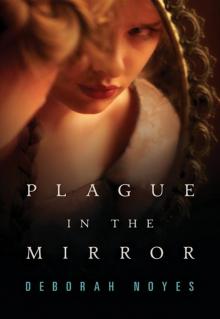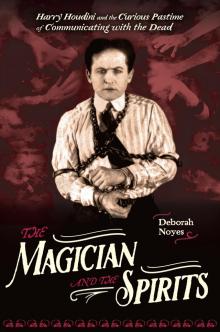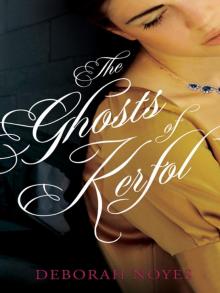- Home
- Deborah Noyes
The Magician and the Spirits
The Magician and the Spirits Read online
VIKING
An imprint of Penguin Random House LLC
375 Hudson Street
New York, New York 10014
First published in the United States of America by Viking, an imprint of Penguin Random House LLC, 2017
Copyright © 2017 by Deborah Noyes
Penguin supports copyright. Copyright fuels creativity, encourages diverse voices, promotes free speech, and creates a vibrant culture. Thank you for buying an authorized edition of this book and for complying with copyright laws by not reproducing, scanning, or distributing any part of it in any form without permission. You are supporting writers and allowing Penguin to continue to publish books for every reader.
Ebook ISBN: 9781101616895
LIBRARY OF CONGRESS CATALOGING-IN-PUBLICATION DATA
Names: Noyes, Deborah, author.
Title: The magician and the spirits : Harry Houdini and the curious pastime
of communicating with the dead / Deborah Noyes.
Description: New York : Viking Books for Young Readers, 2017.
Identifiers: LCCN 2016053762 | ISBN 9780803740181 (hardback)
Subjects: LCSH: Houdini, Harry, 1874–1926—Juvenile literature. |
Magicians—United States—Biography—Juvenile literature. | Escape artists—United States—Biography—Juvenile literature. | Spiritualism. |
BISAC: JUVENILE NONFICTION / Biography & Autobiography / Historical. |
JUVENILE NONFICTION / Games & Activities / Magic. | JUVENILE NONFICTION / Social Issues / Death & Dying.
Classification: LCC GV1545.H8 N69 2017 | DDC 793.8092—dc23 LC record available at https://lccn.loc.gov/2016053762
Version_1
CONTENTS
TITLE PAGE
COPYRIGHT
INTRODUCTION
Impossibility Commences
ONE
HARRY AND BESS HOUDINI, SPIRIT MEDIUMS
OR
The Great Mystifier and the Celebrated Psycrometic Clairvoyant Unveil Mysteries Past, Present, and Future
TWO
DEALINGS WITH THE DEAD
Mediums, Magicians, Ghostly Doings, and Grand Escapes
THREE
THE MOTHER’S BOY
ALONE AT THE STATION
FOUR
THE TORCH BEARER
WHEREIN
Houdini meets Doyle and would find it wonderful to hear from his loved ones in the Beyond but refuses to be duped
FIVE
“IN THE LIGHT”
PHOTOGRAPHIC PHANTOMS
INCLUDING
wholly modern specimens of the art of manufacturing spirit “extras” under cover of darkness through chemical means
SIX
MANIFESTATIONS!
Adventures with Ectoplasm and More
TO WIT
A Rogue’s Gallery of Spiritualist Masters and Frauds
SEVEN
A MENACE TO HEALTH AND SANITY
TO WHICH
the creator of Sherlock Holmes replies: “People have been going mad for years, and you will find on investigation that many go mad on other subjects besides Spiritualism.”
EIGHT
SCIENCE AND SINCERITY
HOUDINI EXPLORES THE LIMITS OF RATIONAL INQUIRY
FINDING
GREAT MINDS IN ECLIPSE
NINE
IT TAKES A FLIMFLAMMER TO CATCH A FLIMFLAMMER
A War on Deception
APPLYING
disguise, sleight of hand, and other methods of the magical trade to the problem of proof
TEN
THE END (OR IS IT?)
DO SPIRITS RETURN?
Houdini claims he will, if he can, though to this day his silence is resolute
NOTES BIBLIOGRAPHY ACKNOWLEDGMENTS PICTURE CREDITS INDEX
Harry Houdini, Handcuff King, circa 1905.
Background: A crowd looks up as Houdini performs his Suspended Straitjacket escape, circa 1916.
INTRODUCTION
Impossibility Commences
Who was Harry Houdini?
Almost everyone has a mental picture of this “mystifier of mystifiers,” the most popular magician and escape artist of all time. Whether crouched over handcuffed wrists, liberating himself from a locked jail cell, or making an elephant disappear, he was a blaze of action—a force of mind, muscle, and will. His audiences gaped in wonder as he swallowed needles (or seemed to), bobbed upside down in a water-torture cell, or dangled topsy-turvy in a straitjacket from a tall building.
Over the course of his career, Houdini went by many names. He made his public debut at Jack Hoefler’s Five-Cent Circus in 1883, a year after his family settled in Milwaukee, Wisconsin. Billed as Ehrich, the Prince of the Air, the spry acrobat and contortionist was nine years old.
People who saw him later, performing in dime museums, sideshows, and jails, and on the big variety stages of vaudeville, knew him variously as King of Cards, Projea the Wild Man, Wizard of Shackles, or the World’s Handcuff King and Prison Breaker. As he was quick to advertise, he was an “eclipsing sensation” who left no challenge unanswered. He was known in “every country on the globe,” defying “duplication, explanation, imitation or contradiction.” And in a life dedicated to dreaming up dazzling tricks, stunts, and escapes, he was his own best invention.
The public knew him by many names but rarely the one he started life with. Born in Budapest, Hungary, in March 1874, Erik Weisz (later Ehrich Weiss) was the son of an impoverished rabbi and a doting mother. Neither parent learned to speak English after immigrating to America, but young Ehrich grew into the picture of New World energy and optimism. He was competitive and ambitious, physically powerful, and powerfully present, all traits that would help shape his career as the consummate showman.
What fewer people know about this most visible of performers is that for decades, Ehrich Weiss (who adopted the stage name Houdini early in his career and would one day autograph his books: “Houdini. That’s Enough”) was preoccupied with things the eye can’t see.
Like many people in the nineteenth and early twentieth centuries, Houdini was intrigued (if not convinced) by the startling idea that spirits not only survive death but can also be contacted and can communicate with the living through a third party called a medium.
THIS BOOK IS THE STORY OF A RATIONAL AND relentless showman whose debunking of deception put him in touch with odd and fascinating characters: mediums who said they could converse with the dead, criminal hucksters, deluded scientists, and committees and investigators with job titles like “Honorary Secretary of the Society for the Study of Supernormal Pictures.”
It’s also the story of a devoted son devastated by the death of his “Sainted Mother,” who swore to investigate spiritual phenomena with an open mind and to uncover and defend truth until the end.
In thirty years, Houdini concluded, in his 1924 book, A Magician Among the Spirits, “I have not found one incident that savoured of the genuine.”
But it was not for want of trying.
PART ONE
“There Is No Death, There Are No Dead”
ONE
Harry and Bess Houdini, Spirit Mediums
“To me it was a lark.” ~Harry Houdini
During the late nineteenth and early twentieth centuries, vaudeville—which brought touring novelty acts together on one stage—was the most popular form of entertainment in American cities.
But in remote small towns, where the vaudeville tours wouldn’t
go, traveling medicine shows and their hodgepodge of players parked their wagons and staged a humbler sort of performance.
The formula was simple: performers took over a street corner, produced musical instruments, and made a racket. Once a crowd gathered, the show’s pitchman or “doctor” stepped up on a platform and sold his miraculous potions or elixirs. Often he invited the audience back to a local auditorium or music hall for more marvels and “medicine” the same evening.
In late 1897, in need of steady work, twenty-three-year-old Harry Houdini and his young bride, Bess—both struggling variety performers—signed on for a fifteen-week tour with “Dr.” Thomas Hill’s California Concert Company, a typical traveling Midwestern medicine show, at twenty-five dollars a week.
The company, which included Swiss bell ringers, a German comedian, and the many-talented Keatons (family of future silent-film star Buster Keaton), gathered on dusty street corners in Kansas and Oklahoma Territory to draw crowds. Houdini (billed as the “Great Wizard”) thumped a tambourine, Bess (the “little vocalist”) sang, and when enough curious onlookers had gathered, Dr. Hill announced the evening’s show and went to work peddling bottled potions.
The season started out well, but at some point audiences began to dwindle. Dr. Hill had heard of other Midwestern shows drawing crowds with séance and mind-reading routines. Would Houdini want to develop a psychic act of his own?
The Great Wizard had seen a few spirit demonstrations in New York and had no high opinion of them. But for a magician with a mind for mechanics, they would be easy to duplicate, and if Houdini could help the show prosper, it was worth a try.
A medicine-show pitchman attracts a crowd in Huntingdon, Tennessee, 1935.
Before a performance one evening in Garnett, Kansas, he visited the local cemetery, “accompanied by the sexton and the oldest inhabi-tant of the town.” He surveyed the graves, jotting down names and ages from the stones. “I had a notebook,” Houdini later recalled in a lecture exposing such deceptions, and if the words carved in marble or granite said too little, “the sexton would tell me the missing data, and the old Uncle Rufus would give me the scandals of everyone sleeping in God’s acre.”
The Houdinis
After a brisk courtship of three weeks, Harry Houdini married Wilhelmina Beatrice “Bess” Rahner, a slight pixie of a girl who sang in an act called the Floral Sisters.
Though Harry’s mother accepted the bride at once, Bess’s mother, a Catholic, couldn’t forgive her daughter for marrying into a Jewish family, and shunned Bess for nearly a decade.
The honeymoon on Coney Island was “cheap” but “glorious,” said Bess. Billed as the Houdinis, the newlyweds now became partners onstage as well as off.
Harry and Bess were devoted for life, despite a few bumps in the road, and he showered her with gifts and little love notes, addressed to “Darling One and Only” and “Precious Lump of Sweetness.”
“Every morning,” Bess recalled, “I would find a dear funny little Message like [this] on my pillow.”
Bess and Harry Houdini in their first year of marriage, 1894.
Houdini spent the day mingling with townsfolk and asked discreet questions. People were only too happy, he learned, to gossip about themselves and their neighbors.
The afternoon crowd had already seen Houdini escape leg irons and handcuffs, and Dr. Hill had hinted, too, at the young man’s extraordinary gift for communicating with the dead. Intrigued, much of the same crowd—and quite a few newcomers—flocked to the local opera house that night to see and hear Houdini in action. He gave them what they came for. Hurling off the ropes that bound him in his chair, he strode downstage as applause faded and the audience grew hushed and uneasy.
In a low, thrilling voice, Houdini mused about the spirit world. Like other performers of the day who included psychic themes (telepathy, hypnosis, mediumship) in their acts, he primed the audience. He closed and opened his eyes. He trembled and gasped as if sensing an invisible presence Words were coming through, he said—names and dates. As his gaze roamed the room, his voice caught to build drama. One by one, he delivered “messages” from Beyond, revealing facts and family secrets that only a handful of people in the community could have known.
The Effect
Magicians often buy or inherit the secrets and apparatus, or equipment, of retiring performers, and Houdini got his Metamorphosis trick this way for twenty-five dollars (a heap of cash at the time). The illusion included a “substitution” trunk—a steamer trunk big enough to hold a person, with airholes—a giant curtained cabinet, and instructions.
Houdini would begin by calling an audience committee onstage. While they examined the props, he stepped into a black flannel sack inside the open steamer trunk. His volunteers taped the mouth of the bag shut. They closed and padlocked the trunk, swaddled it in thick, knotted rope, sealed the knots with wax, and then wheeled it into the curtained cabinet while Houdini thumped and hollered inside to prove he was still there.
“Now then,” called Bess, stepping into the cabinet with the trunk. “I shall clap my hands three times . . . I ask you to watch closely for the—EFFECT.” At the third clap, she whisked the curtain closed. Assistant and trunk disappeared behind the fabric. But almost instantly, the curtain opened again, and out stepped Houdini. Volunteers raced to undo the rope and unlock the trunk. The flannel bag was still inside, still tied up with tape— and inside that? Bess. The baffled audience cheered wildly as a member of the committed extended a hand to help Houdini’s nimble assistant to her feet.
“Just think over this,” Houdini boasted in one of their ads. “The time consumed in making the change is THREE SECONDS!”
It was a feat perfectly suited to Bess’s quick, slight frame and Houdini’s muscular dexterity. The Houdinis’ signature act was a spectacle with staying power. The couple performed it together on and off for years, even after Houdini’s solo career took off.
A theatrical poster advertising the Houdinis’ Metamorphosis act, circa 1895.
Houdini and Bess also did a joint mind-reading act. Bess walked into the crowd and took a dollar bill from an audience member, challenging Houdini to divine its serial number. Her husband concentrated with otherworldly intensity and then, as the crowd hummed with excitement, rattled it off, digit by slow digit. It was all a clever trick—the Houdinis had devised silent and spoken codes for such occasions—but audiences were convinced.
Undated advertisement for the Houdinis’ early Spiritualist act.
Dr. Hill’s own spirits were high when he tallied the receipts, and soon, the California Concert Company was staging spirit acts in a different town each Sunday.
But the Houdinis’ success as fake mediums and mind readers alone couldn’t save Hill’s operation. In early 1898, the medicine show collapsed, and the young couple set out on their own, booking small venues where Harry performed escapes and the duo continued to fine-tune their best-known magic act, Metamorphosis, the “greatest and finest Trunk Mystery the world has ever seen.”
They didn’t banish the “spir-its” from the show, though. They also incorporated spectral messages, mind reading, and levitating tables, sometimes billing themselves as “The Great Mystifier” and “The Celebrated Psycrometic Clairvoyant.”
“I appreciated the fact that I surprised my clients,” Houdini later wrote, “but while aware of the fact that I was deceiving them I did not see or understand the seriousness.” For the time being, he approached the work in a spirit of play. He was living “like a king,” after all, compared to life before séances and mind reading, earning much-needed income by posing as a channel between the living and the dead.
Harry and Bess Houdini with the Welsh Brothers Circus, 1896.
The Houdinis spent several more years performing a mishmash of routines in small circus
es, music halls, and dime museums (a popular form of “lowbrow” entertainment that brought scientific curiosities and shameless thrills under the same roof). Often changing or renaming their routine as they struggled to find the formula for making it in show business, Harry and Bess had yet to focus and refine the act that would eventually put his talents in the forefront, with Bess stepping back into a supporting role.
Miraculous Mentors
During Houdini’s hungry years on the dime-museum circuit, he formed lasting friendships with many of the “freaks”—stars like Count Orloff, the Transparent Man or Human Window Pane (“You Can See His Heart Beat! You Can See His Blood Circulate!”)—who attracted big crowds and bigger salaries. In his 1920 book, Miracle Mongers and Their Methods, Houdini pays tribute to fire-eaters, glass chewers, sword-, stone-, and umbrella-swallowers, and “defiers of poisonous reptiles,” performers like the Incombustible Spaniard, the Human Ostrich, and the Electric Girl. “The dime museum is but a memory now,” he wrote. In three generations he believed it would be completely forgotten. Bess often refused to play the dime museums; vaudeville offered more money, stability, and respectability for the young couple. But Houdini learned some handy tricks there.
A sideshow poster circa 1885 advertising Count Orloff, the stage name of Ivannow Wladislaus von Dziarski-Orloff (1864–1904), who suffered from an unknown wasting disease that made his skin transparent.
By 1899, Houdini was ready to pack it in, give up magic altogether, and resort to teaching others the tricks of his trade. He and Bess moved back to New York to live with his mother, but Harry still had advance bookings to honor, and while performing at a beer hall in St. Paul, Minnesota, he got the break performers dream of. A big-shot manager, vaudeville tycoon Martin Beck, saw his routine and challenged Houdini to escape from a series of handcuffs.

 Plague in the Mirror
Plague in the Mirror The Magician and the Spirits
The Magician and the Spirits The Ghosts of Kerfol
The Ghosts of Kerfol